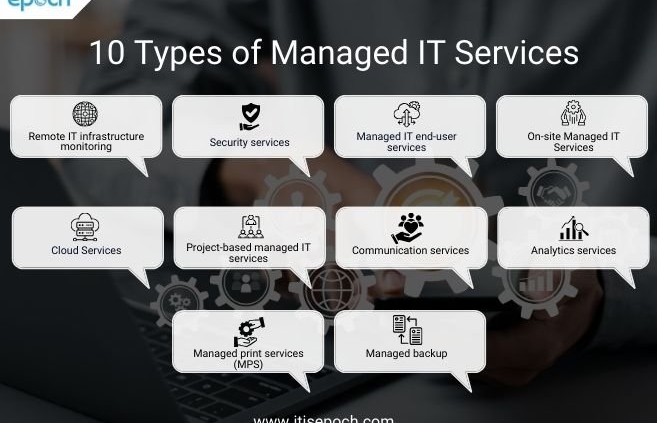10 Types of Managed IT Services You Must Know Before Finalization
The market for types of managed IT services has drastically grown in recent years due to increasing demand for cyber security and state policies. Managed services are tasks and processes done by hiring third-party organizations designed to handle the day-to-day IT operations. Managed service providers deliver the services in a few different ways. Most commonly sorting them by the task they are performing or by the hardware or the system that is involved in operations.
A managed service provides a comprehensive solution where business owners easily deploy the management and support of a specific area, such as network security, cloud computing, or IT infrastructure to a specialized service provider. Suppose you run an e-commerce website where the business owner juggles multiple responsibilities from managing your website and servers to ensuring data security and providing all-day customer support.
Purpose
It’s a lot to handle for businesses so this is where IT support services in Allentown, PA come to play. The managed service provider not only monitors the servers but also ensures website uptime by conducting regular security audits and providing 24/7 managed support. These facilities allow the e-commerce company to focus on its core business activities while enjoying a reliable and secure online presence. These IT MSPs not only provide improved customer satisfaction but also help by drastically expanding the business.
Since IT service providers generally offer their managed services individually, you can choose the ones you want. It is up to the business owners to choose the type of services they want to avail to make an informed decision. Based on your needs, only one or two managed services might be necessary, while in other cases you might need to take a lot of services. Some providers offer packages that bundle the services together, which can be affordable so if you need several managed services, you may want to explore those options.
Types of Managed IT Services (IT MSP) For Your Business
From a high level to common services include work related to managed networks, network security, managed print services, and more. Services under these categories comprise firewall solutions, data backups, reporting and data analytics, and more. The managed IT service provider offers several types according to the needs of the businesses. There are several types of services provided by IT service providers, below are some popular services that the MSPs offer
1. REMOTE IT INFRASTRUCTURE MONITORING
The most popular type of Managed IT Service is remote management and administration of servers, workstations, and mobile devices. Remote management and monitoring are often essential, core services for businesses. Several IT MSPs offer this service as competition to maximize profits is quite intense and owners are under constant pressure. As a result of it new and more specialized types of managed IT services and IT operations.
2. SECURITY SERVICES
The growth of these monitoring-led managed services has prompted MSPs to refine their services and expand IT operations. One prominent route for businesses is managed security services. Customers increasingly rely on service providers to assist with IT systems, cloud infrastructure services, and data security. Due to this, the service providers are building strategies for managed security services or forming partnerships by hiring security companies to deliver high-quality solutions related to cybersecurity under professional guidance.
3. MANAGED IT END-USER SERVICES
End-user services can provide a wide range of solutions, but they often centrally revolve around the IT assistance channels according to the processes an organization has established for its employees and customers. The end-user services include, from the most fundamental level, an IT help desk or service desk solution where the users may resolve the issues that arise from technical difficulties with a team of highly skilled professionals. Issues arise with assistance for operating systems and devices, applications that are installations and upgrades, connectivity issues, and other help desk support IT services. Therefore the enterprise hires the managed IT service provider, but its employees and customers enjoy an overall better user experience.
4. ON-SITE MANAGED IT SERVICES AND IT INFRASTRUCTURE
On-site managed IT services are also called managed field services, on-site IT services provide an MSP assigning experts in a designated area to carry out activities that are related to IT. This also includes installation of equipment or maintenance, cabling or site assessments, cabling or wireless, installations, and much more to expand managed IT services companies. Here, the provider is also accountable for scheduling and deploying, maintaining issue logs, and service requests by providing post-task communications.
5. CLOUD SERVICES
Cloud technology has helped managed IT services to grow and also provide quality services to business owners. MSPs for instance, specialize in infrastructure as a service (IaaS), offering managed public cloud services in collaboration with cloud providers like Google, and Microsoft. Managed IT services, Amazon Web Services (AWS) can also implement and manage the cloud–like consulting, assessments, migrations, and more.
6. PROJECT-BASED MANAGED IT SERVICES
Technological support for the project is yet another category of services falling into managed IT services. The solution-based expertise like Salesforce implementation or SharePoint build technological evaluation, or continuing technical support to run the business on IT infrastructure.
If the companies lack the ability or capacity to complete an important IT project, they might benefit from collaborating with a managed service provider to seek assistance from technical professionals. MSPs usually have a well-defined framework and provide a project schedule and budget to guarantee that a job is completed within the budget allocated with a scheduled parameter.
7. COMMUNICATION SERVICES
Increasingly, enterprise communication comes under IT operations and IT infrastructure, and you may choose to deploy the administration of the communication systems by using managed IT services. Managed communications (sometimes known as unified communications) consolidate telephonic, multimedia, and data communication networks into a single and unified hub.
This implies that employees can have access to all types of communication the company provides. By simply connecting to a single network individually rather than using login credentials for email, video conferencing, and other facilities. Ensuring uptime, encrypting messages, and securing video calls, for managed IT support securing companies. The Voice over Internet Protocol (VoIP) licenses are some of the key features of the IT MSP services that provide this type of managed IT service.
8. ANALYTICS SERVICES
Managed data analytics services enable companies to assist in gathering, assessing, and protecting the cloud computing data of the customers. It includes monitoring the traffic driven by the website or social networking participation. And forecasting how to enhance outcomes by recognizing the trends, The MSP can transform raw data into insights that are simple to comprehend and ready for use to carry out business and are handy in decision-making. You can opt for an all-in-one managed IT service and IT operations for enterprise-wide business intelligence this managed IT service can be based on a project. There are way more specialized cloud computing providers for people analytics, market analytics, financial performance analytics, and so on.
9. MANAGED PRINT SERVICES (MPS)
The Managed print services allow the provider to monitor equipment remotely via cloud computing, It also provides support, upgrades, maintenance, and repair. The services might not be as useful to a company that heavily relies on cloud-based. However, it can be a good option to consider if you need printing needs, such as you will end up requiring hard copy documentation or have a huge number that needs printer access. A managed print service can also provide tracking and a complete audit of print habits to identify hidden costs that can be eliminated.
10. MANAGED BACKUP
Data backup using cloud computing may be bundled with other managed services (such as network, security, and cloud computing). Many service providers offer an additional, comprehensive solution as a standalone option. This may also include backing up data on the cloud servers. Also on other servers by developing a disaster recovery blueprint for data that is lost and retrieving and restoring data. MSPs may assist by identifying your backup requirements. Also may suggest how often backups should be conducted, and recommending the scope and the extent of the recovery process. This helps with network security.
Conclusion
The demand for managed IT services and IT operations from IT service providers is drastically increasing globally. There are several reasons why businesses prefer the managed IT services trend. The primary factors that drive managed services are known as a vital part of the IT sector. They including cyber security, robust cloud services, and IT network management. MSPs help businesses develop perfect and secured IT infrastructure providing all cloud and network security services on one platform.













